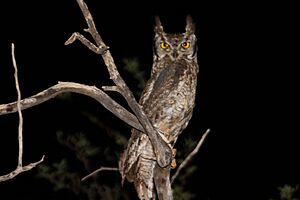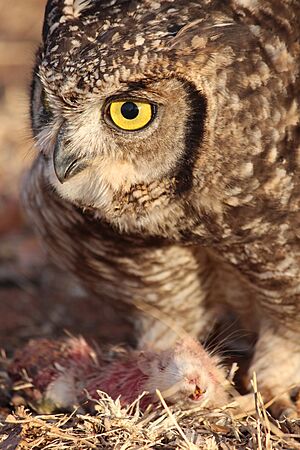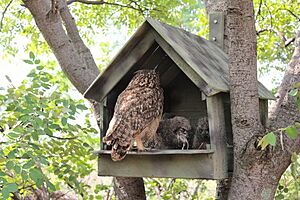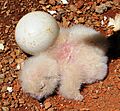Spotted eagle-owl facts for kids
Quick facts for kids Spotted eagle-owl |
|
|---|---|
 |
|
| At night, Tswalu Kalahari Reserve, South Africa | |
| Conservation status | |
| Scientific classification |
The spotted eagle-owl (Bubo africanus) is a cool bird of prey. It's also called the African spotted eagle-owl. This owl is a medium-sized type of owl, and it's one of the smaller kinds of eagle owls. It measures about 45 cm (18 in) long. It weighs between 454 to 907 grams (1.0 to 2.0 lb), which is about the same as a small bag of sugar. Its wings can spread out wide, from 100 to 140 cm (39 to 55 in) across!
This owl has a face that's light off-white or pale yellow. Its eyes are bright yellow. It has two noticeable "ear-tufts" on its head, which look like little horns. Its top feathers are brownish, and its belly is off-white with brown stripes. Before 1999, people thought this owl was the same as the greyish eagle-owl. But now, scientists know they are different species.
Contents
Where Spotted Eagle-Owls Live
Spotted eagle-owls are very common in southern Africa. You can find many of them there. They often live near people, even in towns and cities. That's why they are sometimes called "urban owls." They live all over Africa, south of the Sahara Desert. You can also find them in the Arabian Peninsula. They like thorny grasslands and even gardens in places like Harare, Zimbabwe.
What Spotted Eagle-Owls Eat
These owls mainly eat small animals. Their favorite foods are rodents like mice and shrews. They also hunt small birds, insects, and reptiles. They often swallow their food whole. They might jerk their head a lot and pause while trying to get the food down. Any parts they can't digest, like feathers or bones, come out later as a pellet. This pellet is spit out within a day.
If the prey is too big to swallow, the owl will tear off pieces. They also tear food into smaller bits for their baby owls. The male owl hunts and brings food to the female when she is on the nest. Sometimes, even if food is scarce, he will bring the body of a mouse for the female and young.
Spotted eagle-owls are not picky eaters. They move around a lot to find food. They might stay in one area for a few weeks or months. Then they move when there isn't enough food or it's hard to catch. They usually come back to the same areas every year or two. Adult owls are very protective of their hunting areas. Young owls have to find new places to hunt where older owls won't chase them away.
How Spotted Eagle-Owls Behave
Spotted eagle-owls make musical hooting sounds. The male usually hoots twice: "Hooo hooopoooo." The female answers with three hoots: "Hooo hoo hooo." Young owls don't hoot until they are almost grown up. But even when they are very young, they can hiss loudly if they are scared. They also snap their beaks together like castanets.
They make these sounds their whole lives, especially when they feel threatened. They might lower their head and spread their wings wide like an umbrella. They do this to challenge other owls or to protect their nest and babies. Young owls also make a soft "whickering" sound if they are annoyed. When they are comfortable, young owls make a soft "kreeep" sound every few seconds. If they think they are alone, they call more often and look for their family. Both young and adult owls will snap their bills, hiss, and chatter to scare away enemies.
Like all owls, these birds can be bothered by other birds during the day. In the Gauteng area, a very loud bird called the grey loerie often bothers them. The owls only get peace when it gets dark. Spotted eagle-owls like to bathe. During summer storms, you might see them on tree branches or the ground with their wings spread out.
They like living in rocky places. They often rest in open spots like on the ground, on rocks, or in the tops of trees.
Spotted Eagle-Owl Life Cycle and Reproduction
Spotted eagle-owls usually have only one partner for life. But if their partner dies, they will find a new one quickly. They can start having babies when they are about one year old. They usually build their nests on the ground. However, they have been seen nesting on buildings, like window ledges. They also like to nest in special owl houses.
Breeding usually starts in late July and continues until early February. The female owl lays two to four eggs. She sits on the eggs to keep them warm. She only leaves the nest to eat the food the male brings her. The eggs hatch after about 32 days.
When baby owls are about five weeks old, they will jump out of nests that are off the ground. They spend about ten days on the ground before they can fly. During this time, they learn important skills. They practice hunting and catch small insects. Their parents still bring them bigger food, like rodents. Baby owls make a loud rasping noise when they are hungry. This helps their parents find them from far away.
Sometimes, people find these young owls on the ground and think they are hurt or abandoned. They might try to "rescue" them because they can't fly yet. But this is usually a mistake, as the parents are still caring for them. The young owls can fly when they are about seven weeks old. But they stay with their parents for several more weeks after they learn to fly. Spotted eagle-owls can live up to 10 years in the wild. In zoos or special care, they can live up to 20 years.
Protecting Spotted Eagle-Owls
These owls are not in danger of disappearing globally. They are often the most common type of owl where they live.
In South Africa, it's against the law to catch or keep any native owls without a special permit. Owls need very specific care if they are kept by humans. They need a balanced diet with the right amount of calcium and phosphorus. If baby owls don't get the right food, they can get sick. Their bones might not grow properly, which can be deadly. There are special ways to help owls raised by humans go back to living in the wild.
The main dangers to spotted eagle-owls are:
- Getting hit by cars.
- Hitting electric wires.
- Being hunted by people.
- Getting poisoned by eating poisoned prey.
- Getting sick from parasites.
Young owls and those who have just learned to fly are most at risk.
Gallery








